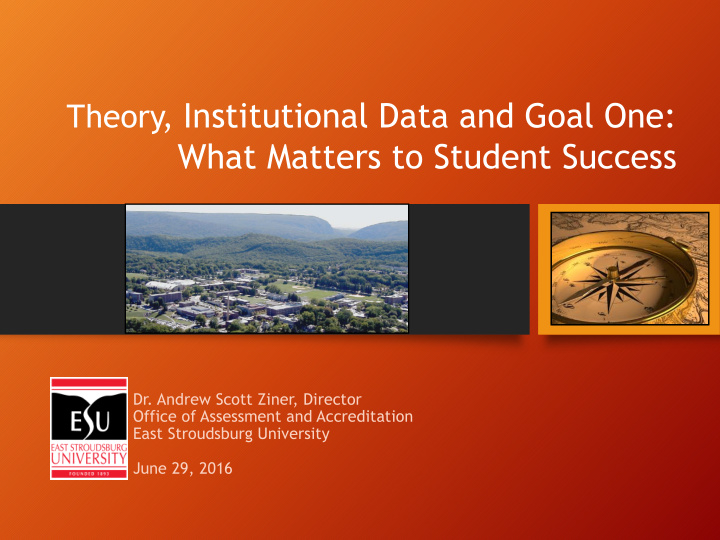



Theory, Institutional Data and Goal One: What Matters to Student Success Dr. Andrew Scott Ziner, Director Office of Assessment and Accreditation East Stroudsburg University June 29, 2016
Creating the conditions that foster student success in college has never been more important
Today’s Objectives 3 • Briefly review and apply a best practices theoretical framework** that helps us envision (and rigorously study) the conditions that foster student success • Integrate into this framework how well ESU is achieving Goal One (student success) of the Strategic Plan when limited to Fact Book data • Spearhead a dialogue on student success, post-presentation ** Source: “ What Matters to Student Success: A Review of the Literature ,” a Commissioned Report for the National Symposium on Postsecondary Student Success, National Postsecondary Education Cooperative, American Council on Education, July 2006.
4
5 About the Student Success Framework • Instead of the familiar “pipeline” analogy depicted by a direct route to educational attainment, this framework provides a more realistic portrayal of current postsecondary education • We see a wide path with twists, turns, detours and occasional dead ends that many students may encounter during their educational career
6
7
8
1 st to 2 nd Year Retention by Race/Ethnicity 9 During the period Fall 2011 to Fall 2014, both URMs show uneven and downward enrollment trends, compared to non-URMs We have our work cut out for us!
1 st to 2 nd Year Retention by Race/Ethnicity 10 During the period Fall 2011 to Fall 2014, both URMs show uneven and downward enrollment trends, compared to non-URMs We have our work cut out for us!
11
12
On Section II: College Experience 13 At the intersection of student behaviors and institutional conditions is student engagement** Why focus on student engagement ? 1. It represents aspects of student behavior and institutional performance that we can do something about 2. Many other factors (e.g., pre-college characteristics) are typically beyond the direct control of the student or the University **The relationship between engagement and desired outcomes of college is well documented.
14
15
Fact Book Metrics that Contribute to the 16 Quality of Student Engagement in One’s College Experience (Section 2) • 5-Year PELL Trends for Freshmen by Race/Ethnicity • 5-Year Total Diversity Trend for First-Time Freshmen • 5-Year Total Diversity Trend for All Undergraduates • 5-Year Total Diversity Trend for All Students (UG + G)
5-Year PELL Trends for Freshmen by Race/Ethnicity 17 Between Fall 2011 and Fall 2015, the number of first year, Pell eligible, black students increased by 228.3 percent and Hispanic students by 174.4%, while the increase among white students was 47.3%
5-Year Total Diversity Trend for First-Time Freshmen 18 • Between Fall 2011 and Fall 2015, the total number of racial/ethnic minorities among first-time freshmen has increased from 23.8% (335 students) to 39.8% (523 students) • This represents a 56.1% increase among first-time freshmen racial/ethnic minorities on campus
5-Year Total Diversity Trend for All Undergraduates 19 • Between Fall 2011 and Fall 2015, the total number of racial/ethnic minorities among all undergraduates has increased from 20.1% (1340 students) to 31.7% (1953 students) • This represents a 45.7% increase in racial/ethnic minorities among all undergraduates
5-Year Total Diversity Trend for All Students (UG + G) 20 • Between Fall 2011 and Fall 2015, the total number of racial/ethnic minorities among all undergraduate and graduate students at ESU has increased from 19.2% (1413 students) to 30.2% (2061 students) • This represents a 45.9% increase in racial/ethnic minorities among all undergraduates
21
Graduation Comparisons between URMs and Non-URMs: 22 URMs (2006-2011) Do URMs have different graduation outcomes than non- URMs? Among 2010 FTFT Freshmen who comprise URMs , 27% graduated in four years, with 57% of this class graduating in five years
Graduation Comparisons between URMs and Non-URMs: 23 Non-URMs (2006-2011) Among 2010 FTFT Freshmen who comprise non-URMs , 36% graduated in four years, with 56% of this class graduating in five years
How Well Has ESU Achieved Goal One 24 (Student Success)? • As a standalone analytic tool, Tableau can be lauded for the ease with which a range of summative, temporal data can be displayed and/or downloaded for analysis • However, as a tool, I offer the following gentle points and reminders: • Data prior to 2011-2012 may not be accurate nor reliable, since the nature of the Legacy System had a range of problems that were addressed through ESU’s transition to Banner as our Student System of Record
How Well Has ESU Achieved Goal One 25 (Student Success)? • Fact Book data captures only a small part of a broader picture of student success. To complete this picture, a wide range of well-organized, multi-method, studies must be implemented. This process is currently underway and, once completed over the next two months, ESU will be poised to fully address Goal One of our Strategic Plan. • Importantly, such wide-ranging efforts also will satisfy MSCHE reaccreditation requirements pertaining to our Strategic Plan as part of a broader strategy to document, measure and assess relevant and aligned Standards.
Thank You for Attending! 26
Recommend
More recommend